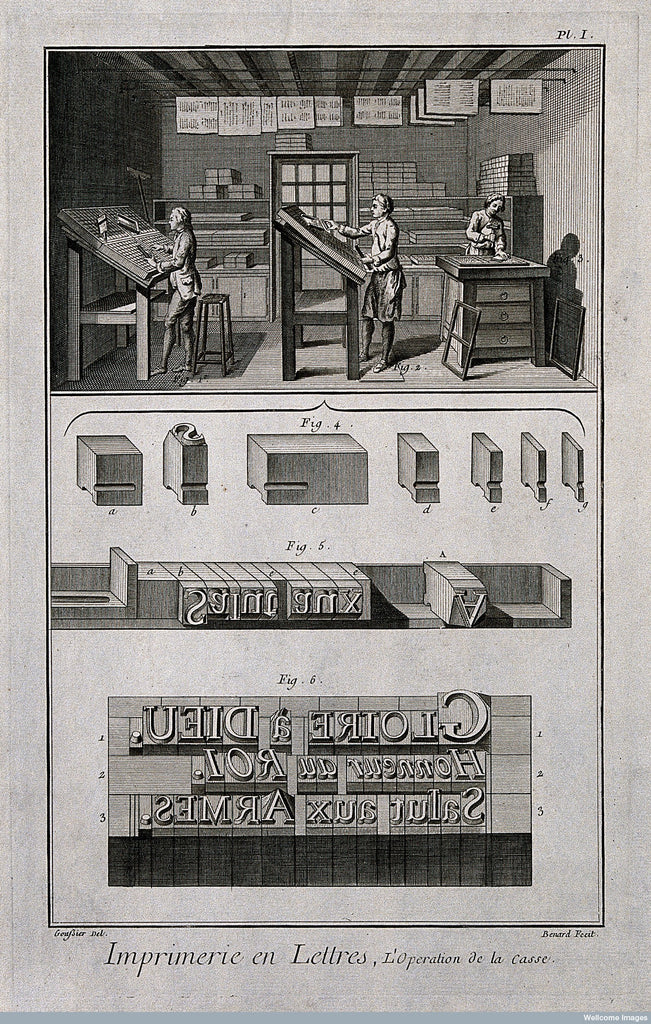What is a First Edition? What do the terms Printing, Impression, and Issue mean?
The term edition refers to all the copies of a book printed at the same time from the same setting of type. The first edition therefore comprises the first copies of a book to be printed and appear on the market at the same time. To understand the terms fully it's important to know how books were manufactured in the past.
During the hand-press era in Europe and North America, roughly 1450-1850, books were printed with movable type. Each letter of the text corresponded to an individual piece of metal type (called a sort), hundreds of which were placed together in a wooden frame called the forme to create what was essentially a giant stamp of one or more pages of the text.
Below, a storage tray of metal type and several lines being prepared in the composing stick before being transferred to the forme. (Photo by Willi Heidelbach, Creative Commons license.)

The image below, made for Diderot’s Encyclopédie in the late 18th century, depicts typesetters at work. The compositors (left and center) select individual pieces of type from large wooden trays and place them into their composing sticks as lines of text. to the right, another employee hammers the type securely into the forme for printing. Above them, printed sheets are drying. The lower half of the page illustrates individual pieces of type and type spacers; type grouped into a line in a composing stick; and several lines of type as they would appear in the forme.

Metal type was expensive and printers had a limited supply, so they could only print a few different sheets of text at any given time and the type would be redistributed once they had enough copies of a particular sheet. Over the course of weeks or months all the sheets for the book would be printed, with the author usually making corrections throughout the process. The completed sheets were then gathered together and distributed to booksellers. All the copies printed together in this way comprise a distinct edition of the work. The limitations of letterpress technology meant that a second or third printing could never be taken from the same setting of type, so each edition was a completely different entity from its predecessors, produced from an entirely new setting of type.
Occasionally you might see a bookseller describe multiple states of a pre-19th century text. This term refers to corrections made during the printing process. An error made by the typesetter might not be noticed and corrected until a number of sheets had already been printed. It was too expensive to throw those pages out and start over, so they were used anyway, creating two states of the text. States are useful to historians and bibliographers who want to understand a book’s publication history, but they usually have little or no effect on a book’s value to collectors, since all the states would have appeared on the market at the same time. (Priority is the term used to describe the order in which copies appeared on the market. Thus there is usually no priority between different states.)
In the middle of the 19th century the printing industry began to change rapidly, and new technologies meant that publishers could make copies of sheets of type and store them in case there was demand for the book at a later date. The image below shows the creation of a mould for a stereotype. A traditional sheet of movable type was covered with plaster or rubber to create a mould that could be stored for months or years. When more copies of the book were needed the mould was used to create a stereotype, a solid metal printing plate.

Printers could now produce multiple printings from the same setting of type, and late-19th and 20th century books are often described with both their edition and printing noted. Only the first printing is considered the true first edition of a book — we will never describe a later printing as the “first edition, fifth printing”, we would simply call it the “fifth printing”. Likewise, if we describe a book as a first edition we mean “first edition, first printing”. The term impression means exactly the same thing as printing, but is used more often by the British and international book trade, while printing is associated with books published in the United States.
By the end of the 19th century, printing technology had changed so much that publishers no longer had to wait until an entire edition was printed before sending copies to market. If an error in the text, binding, or dust jacket was noted part of the way through a press run, the incorrect copies might have already reached bookshops by the time the correction was made. This results in separate issues that are part of the same printing but that appear on the market at slightly different times. Unlike states, issue points can contribute to the market value of a book because collectors are often interested in priority, the order in which copies became available to the public.
For more information see our other articles about rare books.
